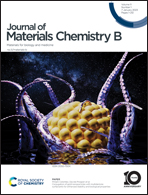Cruciate DNA probes for amplified multiplexed imaging of microRNAs in living cells†
Abstract
The real-time imaging of low-abundance tumor-related microRNAs (miRNAs) in living cells holds great potential for early clinical diagnosis of cancers. However, the relatively low detection sensitivity and possible false-positive signals of a probe in complex cellular matrices remain critical challenges for accurate RNA detection. Herein, we developed a novel aptamer-functionalized cruciate DNA probe that enabled amplified multiple miRNA imaging in living cells via catalytic hairpin assembly (CHA). The cross-shaped design of the cruciate DNA probe improved the stability against nucleases and acted as a modular scaffold for CHA circuits for efficient delivery into tumor cells. The cruciate DNA probe allowed self-assembly through thermal annealing and displayed excellent performance for sensitive miRNA detection in vitro. The cruciate DNA probe could be internalized into nucleolin-overexpressed cells specifically via cell-targeting of the AS1411 aptamer, achieving amplified fluorescence imaging and quantitative evaluation of the expression of miRNAs in living cells. Through the simultaneous detection of intracellular multiple miRNAs, the developed cruciate DNA probe could provide more accurate information and reduce the chances of false positive signals for cancer diagnosis. This approach offers a new opportunity for promoting the development of miRNA-related biomedical research and tumor diagnostic applications.



 Please wait while we load your content...
Please wait while we load your content...